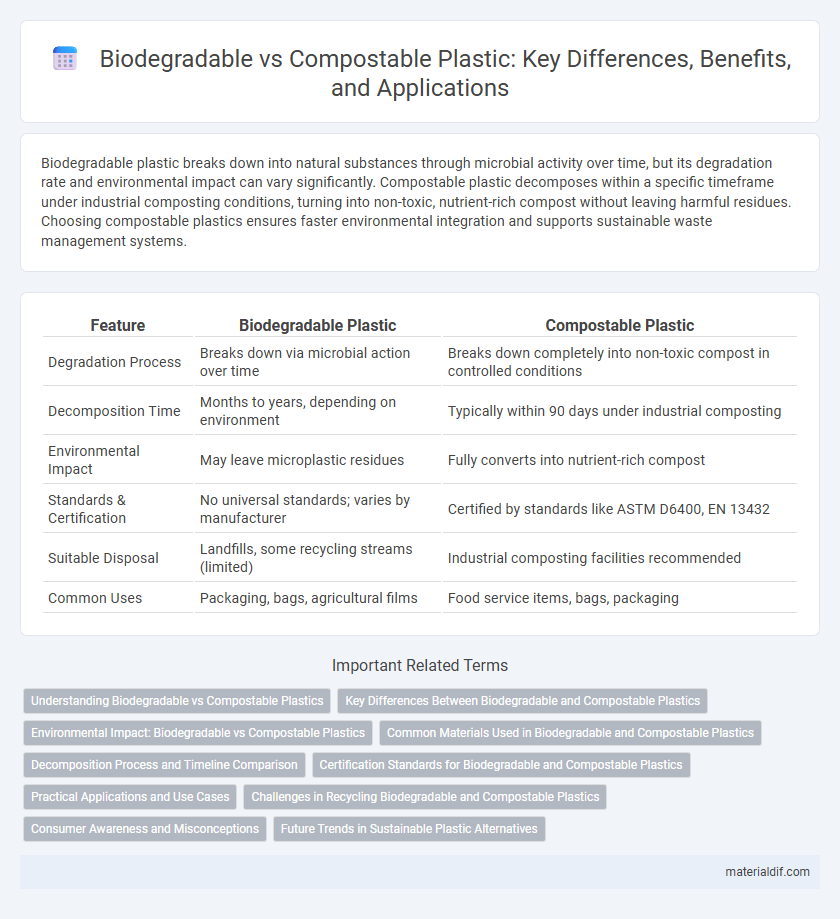Biodegradable plastic breaks down into natural substances through microbial activity over time, but its degradation rate and environmental impact can vary significantly. Compostable plastic decomposes within a specific timeframe under industrial composting conditions, turning into non-toxic, nutrient-rich compost without leaving harmful residues. Choosing compostable plastics ensures faster environmental integration and supports sustainable waste management systems.
Table of Comparison
| Feature | Biodegradable Plastic | Compostable Plastic |
|---|---|---|
| Degradation Process | Breaks down via microbial action over time | Breaks down completely into non-toxic compost in controlled conditions |
| Decomposition Time | Months to years, depending on environment | Typically within 90 days under industrial composting |
| Environmental Impact | May leave microplastic residues | Fully converts into nutrient-rich compost |
| Standards & Certification | No universal standards; varies by manufacturer | Certified by standards like ASTM D6400, EN 13432 |
| Suitable Disposal | Landfills, some recycling streams (limited) | Industrial composting facilities recommended |
| Common Uses | Packaging, bags, agricultural films | Food service items, bags, packaging |
Understanding Biodegradable vs Compostable Plastics
Biodegradable plastics break down naturally through microbial activity over time but may leave behind microplastics or residues, depending on environmental conditions. Compostable plastics decompose into nutrient-rich organic matter within a defined timeframe under industrial composting conditions, ensuring no toxic residue remains. Understanding the distinctions involves recognizing that compostable plastics meet specific standards such as ASTM D6400 or EN 13432, while biodegradable plastics lack uniform certification and vary widely in breakdown efficacy.
Key Differences Between Biodegradable and Compostable Plastics
Biodegradable plastics break down into natural elements through microbial activity over time, but the process varies widely depending on environmental conditions. Compostable plastics require specific conditions, such as controlled temperature, humidity, and microbial presence, to fully decompose into non-toxic components within a defined period. Key differences include biodegradability timelines, environmental requirements, and certification standards like ASTM D6400 for compostable plastics.
Environmental Impact: Biodegradable vs Compostable Plastics
Biodegradable plastics break down through natural processes but can leave behind microplastics that harm ecosystems, whereas compostable plastics fully decompose into non-toxic organic matter within specific industrial composting conditions. Compostable plastics reduce landfill volumes and lower greenhouse gas emissions by accelerating organic waste recycling, aligning with circular economy goals. Environmental impact varies significantly depending on proper disposal infrastructure and adherence to certified composting standards.
Common Materials Used in Biodegradable and Compostable Plastics
Common materials used in biodegradable plastics include polylactic acid (PLA), polyhydroxyalkanoates (PHA), and starch blends, which break down through microbial activity under specific environmental conditions. Compostable plastics often incorporate PLA and polybutylene adipate terephthalate (PBAT), designed to decompose efficiently in industrial composting facilities, converting into nutrient-rich compost within weeks. Both types rely on organic-based polymers, but compostable plastics must meet stricter standards like ASTM D6400 or EN 13432 to ensure complete biodegradation without leaving toxic residues.
Decomposition Process and Timeline Comparison
Biodegradable plastic breaks down through natural microbial activity into water, carbon dioxide, and biomass, typically requiring months to several years depending on environmental conditions. Compostable plastic undergoes decomposition in industrial composting facilities within 90 to 180 days, converting into nutrient-rich compost without leaving toxic residues. The key distinction lies in compostable plastics meeting strict standards such as ASTM D6400 or EN 13432, ensuring rapid and complete degradation under controlled settings, unlike biodegradable plastics that may degrade slowly and variably.
Certification Standards for Biodegradable and Compostable Plastics
Biodegradable plastics must meet standards such as ASTM D6400 or EN 13432, which specify controlled degradation timelines and environmental conditions for breaking down. Compostable plastics require certification under standards like OK Compost or BPI Compostable Product Certification, ensuring the material biodegrades in industrial composting facilities without leaving toxic residues. These certifications regulate disintegration rate, ecotoxicity, and heavy metal content to guarantee environmental safety and compost quality.
Practical Applications and Use Cases
Biodegradable plastic is designed to break down through microbial activity over time, making it suitable for packaging, agricultural films, and disposable items where gradual degradation is acceptable. Compostable plastic, meeting ASTM D6400 or EN 13432 standards, decomposes completely into organic matter within industrial composting facilities, ideal for food service items, coffee pods, and waste bags requiring rapid eco-friendly disposal. Both types reduce landfill impact, with compostable plastics providing faster soil integration and stricter end-of-life processing conditions.
Challenges in Recycling Biodegradable and Compostable Plastics
Recycling biodegradable and compostable plastics presents significant challenges due to their differing chemical compositions and degradation processes, which complicate sorting systems in conventional recycling facilities. Contamination of recyclable plastic streams by these materials often results in lowered quality of recycled products and increased processing costs. Furthermore, the lack of standardized regulations and consumer awareness contributes to inefficiencies in waste management and undermines efforts toward a circular plastic economy.
Consumer Awareness and Misconceptions
Consumer awareness of biodegradable plastic often suffers from misconceptions, with many believing all biodegradable plastics decompose quickly in natural environments, while in reality, decomposition rates vary and require specific conditions. Compostable plastics demand certified industrial composting facilities to break down effectively, yet consumers frequently mistake them for biodegradable materials suitable for home composting. Clear labeling and education are essential to bridge the knowledge gap and guide proper disposal, reducing environmental impact.
Future Trends in Sustainable Plastic Alternatives
Biodegradable plastics break down through microbial activity but may leave microplastic residues, while compostable plastics fully disintegrate into non-toxic components under industrial composting conditions. Future trends indicate a growing adoption of bio-based polymers and enhanced enzymatic additives to improve degradation rates and environmental safety. Innovations in circular economy models and regulatory support are driving increased investment in scalable, sustainable plastic alternatives.
Biodegradable Plastic vs Compostable Plastic Infographic

 materialdif.com
materialdif.com